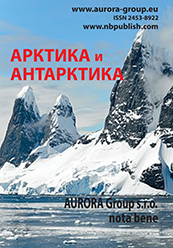Natural resources of the Arctic and Antarctica
Reference:
Parshin, A.V., Cherednichenko, A.E., Goryachev, I.N., Ikramov, Z.L., Trusova, V.V., Kurina, A.V., Kachor, O.L. (2025). Express assessment of air quality in several settlements of Eastern Eurasia based on the results of snow geochemical studies. Arctic and Antarctica, 4, 1–32. https://doi.org/10.7256/2453-8922.2025.4.74123
Abstract:
The features of atmospheric pollution in several settlements of various sizes, with significantly different levels of economic activity, located in different landscape and morphological conditions across a significant territory from the Ural Mountains to the Pacific Ocean have been studied. Students from the Siberian School of Geo-Sciences of Irkutsk National Research Technical University, coming from various cities, collected snowpack samples during the winter break, carried out sample preparation on-site, and then brought samples of snowmelt water and dry residue to the Institute's laboratories. The aim of detailed characterization of the atmospheric geochemical situation in each area was not set; the work is aimed at studying the possible ranges of technogenic and natural variability of concentrations of insoluble and soluble forms of pollutants in the air of industrial and background areas within the northeastern part of Eurasia, which is necessary for the development of a theoretical basis for ecological monitoring systems and assessment of the background state of natural and anthropogenic complexes within various projects of economic development of this vast and resource-rich part of Russia. Since the entire area considered is characterized by a long winter, the best way to integrally assess air quality is through studies of the snow cover. This work examined the chemical composition of the solid residue and snowmelt water and conducted a comparative assessment of median and limit concentrations among different sites. The authors consider snow geochemical surveying as the most promising method for studying background atmospheric states and assessing the impact of new and existing industrial facilities on it, which should become an integral part of the ecological support of economic activities in northern regions. However, the regulatory framework for such data is currently lacking, and new data on the snow geochemistry of various northern territories must be introduced into scientific circulation for its formation, as only on the basis of summarizing a significant volume of geochemical information can reliable and justified judgments be made regarding regional and local background issues, facts of its exceedances, and the significance of these exceedances. In addition to the direct data from various regions with different levels and types of load, among the important results are the factual assessments of the informativeness of various approaches to the methodology of snow geochemical studies.
Keywords:
Primorye, geochemical background, Irkutsk region, background state assessment, Chelyabinsk region, snow cover, heavy metals, environmental monitoring, snow geochemical survey, atmospheric pollution
 This work is licensed under a Creative Commons Attribution-NonCommercial 4.0 International License.
This work is licensed under a Creative Commons Attribution-NonCommercial 4.0 International License.











 © 1998 – 2025 Nota Bene. Publishing Technologies. NB-Media Ltd.
© 1998 – 2025 Nota Bene. Publishing Technologies. NB-Media Ltd.




